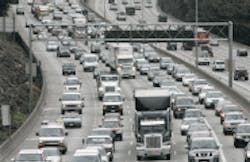“Increasing traffic congestion places a tremendous burden on the economy as well as individuals. When traffic congestion increases in a region, it reduces the level of personal and commercial mobility, making a region less attractive to both employers and employees.” –William Wilkins, The Road Information Program’s executive director
If you survived a Thanksgiving holiday pilgrimage by car this year (I, thankfully, faced no such biblical journey this time!) probably the very last thing you want to discuss (or remember) is the traffic.
AAA, for one, projected that 42.2 million Americans would don their travellin’ shoes for the recent Thanksgiving holiday this year, with said holiday “travel window” starting Wednesday, November 24 and ending yesterday on Sunday, November 28.
Trips by automobile were expected to remain the dominant mode of transportation for 2010 Thanksgiving holiday travel, as well, with 94% of travelers – some 39.7 million people – projected to drive to their destination (and back again) this year.
So, in the spirit of such a “asphalt” holiday, NAVTEQ’s Traffic.com site compiled a “top 10” list of the U.S. cities with the worst traffic congestion, according to their own in-house pool of data compiled by 400 experts monitoring traffic 24/7 in 113 national markets.
Those cities, listed in order with the very worst at the top, are:
New York
Washington DC
San Francisco
Seattle
Los Angeles
Philadelphia
Chicago
Dallas
Atlanta
Houston
Now, traffic congestion in general – and in these cities especially – is nothing new. Indeed, according to the Texas Transportation Institute’s (TTI) urban mobility report, Americans annually lose a total of 4.2 billion hours in traffic congestion, wasting 2.9 billion gallons of fuel and $78.2 billion each year.
Question is, though, what to do about it? Some of the solutions that are being used worldwide to combat traffic congestion don’t go over too well with U.S. drivers. Take the concept of “congestion pricing” for example. It’s been used with great effect in Stockholm, Sweden, but only got the “go ahead” as policy following a city-wide referendum on the matter – and I just don’t think “congestion pricing” as a traffic management strategy would find much support among urban U.S. voters.
There’s another school of thought on traffic management that focuses on the vehicle parking issue. By removing what these experts dub “free” curbside parking, and implementing high rates of “pay-for-parking” meters in downtown locations, this would drive more folks to use alternative forms of transportation in lieu of cars – thus reducing not only traffic congestion but petroleum consumption and emission levels.
Such “parking” strategies are controversial, to say the least, but it’s a measure of how difficult traffic congestion is becoming that folks are thinking along these lines.
The Road Information Program (TRIP) noted that increased traffic congestion is the result of increasing travel outpacing the expansion of the nation’s roadway system. For example, according to TRIP’s analysis of Federal Highway Administration data, travel on the nation’s major roadways increased by 39% from 1990 to 2005 – yet lane mileage increased by only 4% during that same period.
“Vehicle travel on our highways is increasing at a rate nearly ten times greater than new capacity is being added. This is one of the reasons that 36% of America’s major urban roadways are congested during peak hours,” noted William Wilkins, TRIP’s executive director.
In TRIP’s view, relieving traffic congestion will require a balanced approach that includes numerous strategies, such as: adding roadway capacity, largely along existing routes; improving the efficiency of the existing system through the use of managed lanes, HOT or HOV lanes, reversible and “contra-flow” lanes, moveable medians, ramp metering, improved signalization, and improved incident management; and improving public transit service.
However, according to the U.S. Department of Transportation, through 2025, the U.S. faces a $189 billion shortfall in the cost to maintain urban roadways in their current condition and a $375 billion shortfall in the cost to make significant improvements to urban roadways.
State transportation funding is threatened by the continuing fiscal crisis in state budgets, which in fiscal year 2010 prompted a $74.4 billion reduction in overall state spending, noted TRIP. State financial needs also continue to far surpass expenditures, with the National Governors Association projecting total state shortfalls for 2010-2011 of more than $127 billion.
That lack of funding is critical, said TRIP, because transportation agencies can actually reduce pavement life cycle costs by adopting a pavement preservation approach that emphasizes making early initial repairs to pavement surfaces while they are still in good condition and the use of higher-quality paving materials, which reduces the cost of keeping roads smooth by delaying the need for costly reconstruction.
Yet the states – and the federal government – just don’t have the cash to do it. Does it mean tolling, pay-for-parking, and congestion pricing are our only options to find the funds necessary to simultaneously bring our roadways back up to snuff and help relieve traffic congestion? Or can we re-arrange how current tax monies – in the form of fuel taxes – is collected and spent by the states and feds? These are questions we need to find answers too – and sooner rather than later, methinks.
